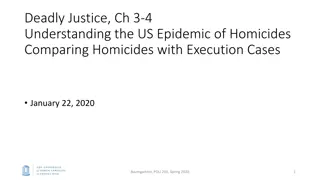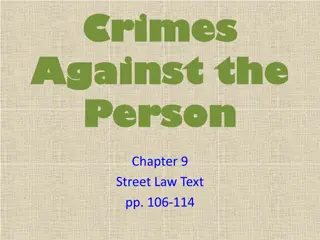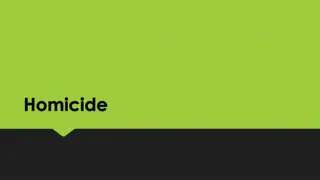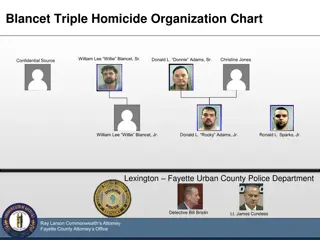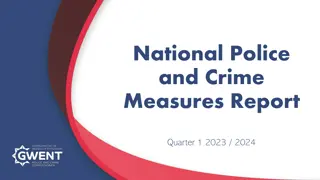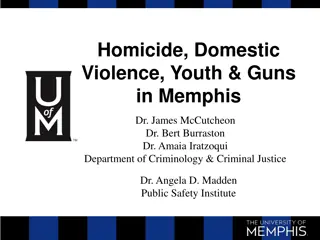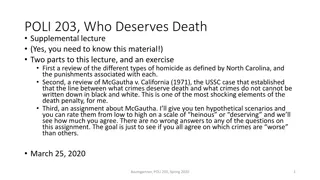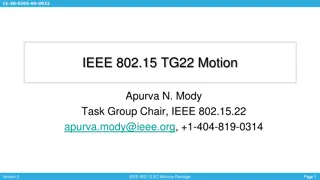
St. Louis City Crime Analysis: Predictive Model for Homicide Rates in 2015
Explore the St. Louis City Crime Analysis project focusing on generating a predictive model to forecast homicides in 2015. The study delves into dividing the city into geographic subsets to predict homicide rates by area. Key variables like education, income, race, and more are analyzed. The methodology involves collecting data from St. Louis City Police from 2010 to 2014, creating alternative variables, and adjusting data to fit geographical subsets. Despite challenges in data collection, the project aims to present findings to city authorities for strategic intervention.
Download Presentation

Please find below an Image/Link to download the presentation.
The content on the website is provided AS IS for your information and personal use only. It may not be sold, licensed, or shared on other websites without obtaining consent from the author. If you encounter any issues during the download, it is possible that the publisher has removed the file from their server.
You are allowed to download the files provided on this website for personal or commercial use, subject to the condition that they are used lawfully. All files are the property of their respective owners.
The content on the website is provided AS IS for your information and personal use only. It may not be sold, licensed, or shared on other websites without obtaining consent from the author.
E N D
Presentation Transcript
St. Louis City Crime Analysis 2015 Homicide Prediction Presented by: Kranthi Kancharla Scott Manns Eric Rodis Kenneth Stecher Sisi Yang
Project Objectives Generate a predictive model to forecast 2015 homicides in St. Louis City Divide St. Louis City into geographic subsets to forecast homicide rates by area Present findings to St. Louis City Police Chief for further use in identifying critical areas to better design & implement strategic measures
Methodology Gather data from St. Louis City Police on homicides over the past 5 years from 2010 to 2014 Generate alternative variables that can influence whether an area is likely to have high or low homicide rates Identify sources that have data available for the variables selected covering St. Louis City Adjust data to fit geographic subsets of St. Louis City Select a model that best incorporates these variables to a predictable outcome
Background St. Louis ranked 4thmost dangerous city in the US in 2014 38 homicides per 100K people St. Louis has higher homicide rates than similar cities
Variables Selected Education (e) Percentage of the population with a High School Education Median age (ma) Income (i) Poverty level (p) Percentage of vacant homes (v) Race Percentage of the population that is white (w) Percentage of the population that is African American (aa)
Data Collected Searching available data sources, identified the US Census Bureau as the source with data that can be best segmented among areas Selected 21 St. Louis City zip codes as subsections due to the availability of representative data for the areas that can be applied to homicides in those areas Data availability for neighborhoods not available and there was challenges accurately converting data into neighborhood classification
Data Collected Using average data of previous 4 years data to predict 2015 due to unavailability of 2014 data Tested the effects of Year using dummy variables SUMMARY OUTPUT Dummy variables for Year Insignificant in various scenarios Regression Statistics Multiple R R Square Adjusted R Square Standard Error Observations 0.137813923 0.018992677 -0.017795097 5.943583976 84 ANOVA df SS MS F Significance F Regression Residual Total 3 54.71428571 18.238095240.516276875 0.672255836 2826.095238 35.32619048 2880.809524 80 83 Coefficients 7.857142857 -1.285714286 -1.952380952 Standard Error 1.296996356 6.057952918 4.26885E-08 5.27603785210.43824786 5.276037852 10.43824786 1.834229836 -0.7009559330.485364402 -4.9359479892.364519418 -4.935947989 2.364519418 1.834229836 -1.0644145640.290343155 -5.6026146561.697852751 -5.602614656 1.697852751 1.834229836 -1.0903758950.278820968 -5.6502337041.650233704 -5.650233704 1.650233704 t Stat P-value Lower 95% Upper 95% Lower 95.0% Upper 95.0% Intercept D2013 D2012 D2011 -2
Model Building Ran regression models on each individual variable to identify most significant relationships over 84 samples of homicides per zip code per year Significant individual relationships Education (e) Income (i) Poverty (p) Race (w) (aa)
Alternative Variables Tested 20 multiple regression combinations to predict homicides based upon variables from the previous year 1. Education, Income, Poverty, Vacant Homes, Age & Race R-square- 0.598759 2. Education, Income, Vacant Homes, & Age R-square- 0.578521 3. Education, Income & Age R-square- 0.568169
Application Selected alternative 1 due to the most significant R Square Regression Statistics Multiple R R Square Adjusted R Square Standard Error Observations Y=29.06+(e*-32.25)+(i*-.00011)+(p*-.52)+(ma*.51)+(aa*-8.96)+(w*-14.4) 0.773795071 0.598758813 0.561802387 3.899897829 84 ANOVA df SS MS F Significance F 7.37691E-13 Regression Residual Total 7 1724.91009 246.4157271 16.20175139 1155.899434 15.20920308 2880.809524 76 83 Coefficients 29.05589603 -32.24792699 -0.000105509 -0.516661479 4.684096084 0.513167113 -8.955614527 -14.40117397 Standard Error 15.1714441 1.915170095 0.059233387 9.515668292 -3.388929291 0.001114882 -51.20002289 -13.2958311 -51.20002289 -13.2958311 6.79804E-05 -1.552045854 0.12480582 -0.000240903 4.424811453 -0.116764632 0.907354582 -9.329437253 8.296114295 -9.329437253 8.296114295 3.66580138 1.277782291 0.205215444 -2.616980117 11.98517229 -2.616980117 11.98517229 0.139301639 3.683855533 0.000428016 0.235723854 0.790610371 0.235723854 0.790610371 13.96115838 -0.641466437 0.523149587 -36.76167127 18.85044221 -36.76167127 18.85044221 15.56259025 -0.925371274 0.357701892 -45.39675871 16.59441077 -45.39675871 16.59441077 t Stat P-value Lower 95% -1.16065363 59.2724457 Upper 95% Lower 95.0% Upper 95.0% -1.16065363 Intercept Education Income Poverty % Vacant Homes Median Age % African American % White 59.2724457 2.9886E-05 -0.000240903 2.9886E-05
Model Application Applied coefficients to 2014 data average for zip codes Y=29.06+(e*-32.25)+(i*-.00011)+(p*-.52)+(ma*.51)+(aa*-8.96)+(w*-14.4) Zip Code Education 63101 63102 63103 63104 63106 63107 63108 63109 63110 63111 63112 63113 63115 63116 63118 63119 63120 63136 63137 63139 63147 Income $ 51,798 $ 53,881 $ 33,739 $ 44,437 $ 15,027 $ 26,738 $ 30,405 $ 59,499 $ 38,610 $ 31,637 $ 30,226 $ 24,788 $ 26,045 $ 41,820 $ 28,887 $ 67,470 $ 24,192 $ 32,057 $ 35,514 $ 46,747 $ 30,400 Poverty 18.2% 9.0% 23.8% 29.0% 53.6% 38.6% 31.6% 9.5% 21.5% 30.5% 32.5% 37.3% 33.2% 21.3% 32.5% 7.9% 38.0% 26.6% 23.4% 11.8% 28.7% % Vacant Homes Median Age 32.1% 25.3% 32.5% 18.0% 20.9% 35.7% 15.4% 8.5% 20.2% 20.3% 26.1% 32.2% 23.8% 13.6% 26.4% 6.2% 28.8% 16.2% 11.2% 10.3% 18.3% % African American % White 49.0% 45.6% 41.6% 51.8% 94.8% 87.5% 35.8% 6.5% 38.1% 34.8% 70.8% 93.8% 98.2% 21.3% 52.6% 9.3% 93.0% 87.1% 75.2% 8.8% 91.1% 91.9% 86.4% 87.2% 74.7% 69.2% 72.9% 89.4% 91.9% 86.1% 75.2% 81.1% 77.8% 75.4% 81.3% 77.7% 95.8% 73.1% 80.8% 84.6% 89.4% 77.8% 32.0 36.4 30.6 31.3 24.7 34.7 29.9 37.4 32.9 34.6 32.1 36.9 35.2 35.3 31.4 39.7 33.9 33.7 34.0 37.8 38.7 47.3% 48.9% 51.5% 45.3% 1.7% 10.2% 54.0% 88.8% 53.8% 60.3% 23.8% 1.7% 3.3% 66.3% 37.4% 85.5% 2.3% 9.0% 22.0% 84.4% 5.2%
Prediction for 2015 2015 Forecasted Homicides St. Louis City 63101 63102 63103 63104 63106 63107 63108 63109 63110 63111 63112 0 4 3 5 10 13 2 0 4 8 7 63113 63115 63116 63118 63119 63120 63136 63137 63139 63147 13 12 6 8 0 13 8 6 2 13 Forecast Total 137 Homicides
Conclusion 2015 St. Louis City Forecast 137 homicides Additional police resources recommended in zip codes 63106, 63107, 63113, 63115, 63120 & 63147 There is a lot of randomness & variability in actual homicides that are unable to be related to available data
Sources http://www.slmpd.org/Crimereports.shtml http://factfinder.census.gov/faces/nav/jsf/pages/index.xhtml http://www.marketwatch.com/story/the-10-most- dangerous-cities-in-america-2014-11-20




